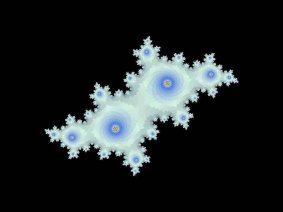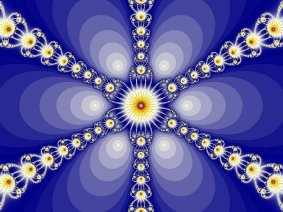|
VIII. Finite Attractors Not all orbit sequences z0, z1, z2… zn tend towards infinity. (For some fractals, very few do!) Orbits that do not tend to infinity most often converge to a single point or a periodic cycle. While many of the techniques discussed so far can be applied directly to such convergent sequences, some require a little tweaking. Still, it is often useful to search for finite attractors directly. The simplest method for doing this is to look for a decreasing change in z. As zn converges on a fixed point, |zn-zn-1| tends towards zero. Once this difference drops below some threshold, we consider the point sufficiently converged to the finite attractor and we color accordingly. (We could color based on the iteration count or any other algorithm we want.) Using the magnitude of the difference between consecutive iterations produces circular iteration bands, but just as changing the shape of the bailout region R for divergent sequences changes the shape of discrete iteration bands, so can a similar change can be used for convergent sequences. This technique works well for sequences which converge to a single point, but some adaptations must be made to catch points which converge to a periodic cycle. To do this, one iterates to a fixed number of iterations, then the entire sequence is examined to find the first zk which is within some threshold distance of the final zn. In this way, no matter which point in the periodic cycle zn settles on at the predetermined iteration limit, at least one value along the way almost certainly has approached within a small distance of that point as the sequence converges on the periodic cycle.
Figs. 6a, 6b. Figure 6a shows the attractors of a connected Julia set z2+c. Figure 6b shows the attractors (roots) from the equation z6-1=0 iterated under the Newton-Raphson Method [ zn+1 = zn - f(zn) / f’(zn) ].
VisMath Home |

